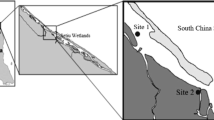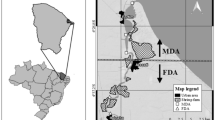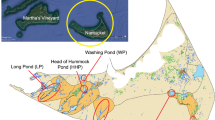Abstract
The present study is the first to report the total mercury concentration of 37 fish species collected from Wujiang River, which is the largest branch on the southern bank of Yangtze River, China and proposed for hydropower development. Total mercury concentrations varied among the 37 subtropical species examined. We found higher mercury concentrations in carnivorous species demonstrating greater mercury bioaccumulation in species with more predatory feeding habits. There is no significant difference between fish grouped by habitat preference and feeding habit. However, carnivorous species preferring benthic positions had higher total mercury concentrations than others suggesting that mercury accumulation is related to the interaction of feeding habit and habitat preference. In our study, fish that are bottom living and feed on other fish or aquatic animals are more likely at high risk of mercury exposure. Additional mercury contamination and future impoundment may raise mercury concentration in fish in the Wujiang causing concern for human health and ecological impacts.
Similar content being viewed by others
Explore related subjects
Discover the latest articles, news and stories from top researchers in related subjects.Avoid common mistakes on your manuscript.
Introduction
Mercury has been well known as an environmental pollutant for several decades. In the aftermath of the discovery that mercury from industrial pollution was the cause of Minamata disease in Japan (Eto 1997), much attention has been focus on mercury contamination in aquatic ecosystem. Fish, which stand at the top of aquatic food chain, are known to accumulate mercury (Paller and Littrell 2007). The significance of mercury in fish is mainly with respect to potential adverse effects on the health of humans and wildlife species that rely on fish as a food source and on the fish populations themselves (Uryu et al. 2002; PHRTE 2007).
In recent years, field surveys on mercury contamination have been extensively carried out in different parts of the world. Mercury uptake and depuration in fish is partly affected by several biological factors of fish such as species, size, weight, length and age (Bidone et al. 1997; Svobodová et al. 1999; Ramlal et al. 2003; Evans et al. 2005; Gammons et al. 2006; Burger and Gochfeld 2007; Kinghorn et al. 2007; Rask et al. 2007; Tuomola et al. 2008). However, only a few studies have focused on the effect of feeding habits on mercury bioaccumulation in a large number of fish species in the same water body (Bidone et al. 1997; Régine et al. 2006; Dorea et al. 2006; Marrugo-Negrete et al. 2008). Studies of the effect of other biological factors on mercury accumulation in many species of wild fish from one waterway are still lacking in the world and need to be conducted to understand better what conditions are most likely to result in high mercury exposure of aquatic organisms.
Wujiang River is the longest tributary on the southern bank of Yangtze River, which is the third largest river in the world. Under the state plan, 11 hydropower stations will be built on the Wujiang River. Wujiang River is located a high background mercury zone of China (Gustin et al. 1999). Thus it is urgent to document mercury concentration in different species before this waterway is impounded. So far, there is no record of mercury levels in fish from Wujiang River. The main purposes of this study were to investigate mercury concentration in fish from Wujiang River and discuss what biological factors may affect mercury accumulation in fish.
Materials and methods
Wujiang River is 1,037 km long and its valley area is 88,000 km2. It rises in the Wumeng Mountains in the Weining County of west Guizhou. The main stream runs through Liuguang, Wujiangdu, Sinan, Yanhe, Siqu and Gongtan from where it goes to Chongqing Province and flows into the Yangtze River at Fuling City. Wujiang River is located a high background mercury zone of China (Gustin et al. 1999). Mercury mines in Wujiang River basin have recoverable deposits of 18,600 tons, sources of potential additional mercury to the river.
Figure 1 shows the sampling stations in the Wujiang River. The investigations were carried out in July and October 2007. During the sample period, 228 individuals representing 37 fish species were caught by gill net from the docks of Lujiao Town, Wangzu Town, Yanhe County and Pengshui County along the river. Each fish was measured for body weight and length. A filet of 100–200 g of muscle tissue was cut from the dorsal area. Fish muscle samples were immediately wrapped in plastic bags and placed in an ice box, transported to the laboratory and kept in a freezer (−20°C). Total mercury concentrations of fish muscle samples were measured by an atomic absorption spectrometer according to the methods published by Ministry of Health of the People’s Republic of China (MOH) and Standardization Administration of the People’s Republic of China (SAC) (2003). All statistical tests were performed using SPSS (version 13.0). According to Ministry of Water Resources of the People’s Republic of China (MWR) (1998), average mercury concentrations were calculated using 0.001 for values less than the detection level (0.002 mg kg−1 WW).
Results
Species average mercury concentration by sampling location and overall for the entire river, range of body length and weight, and grouping by feeding and habitat preference are listed in Table 1. The average total mercury concentration of all individual fish was 0.063 mg kg−1 WW (n = 228). Four individual samples (1.8%) were under the detection level. Three individual samples (1.3%) exceeded the hygienic standard of 0.3 mg kg−1 total mercury (MOH 1994). One sample exceeded the WHO guideline of 0.5 mg kg−1 WW (WHO 1990).
No significant correlation was found between total mercury concentration and body length or weight across all individual fish (Length: n = 228, R 2 = 0.000, P = 0.859; Weight: n = 228, R 2 = 0.013, P = 0.094) and within any species. The total mercury concentrations of fish with different feeding habits and habitat preferences are shown in Fig. 2. The average total mercury concentrations of carnivorous and omnivorous fish were 0.075 and 0.058 mg kg−1 WW, respectively. There was no significant difference between the total mercury in carnivorous and omnivorous fish (independent-sample t test, P = 0.090). The average total mercury concentrations of pelagic, mesopelagic and benthic fish were 0.061, 0.057 and 0.067 mg kg−1 WW, respectively. There was no significant difference between the total mercury in pelagic, mesopelagic and benthic fish (SNK, P = 0.646). However, the total mercury concentration in carnivorous, benthic fish is significant higher than all others (independent-sample t test, P = 0.045).
Discussion
There are only a few published studies documenting mercury concentrations in a wide variety of species from one natural water system. Previous field surveys of mercury contamination were conducted in fish of 16 species from Tartarugalzinho River, Amapa State, Northern Amazon, Brazil (Bidone et al. 1997), 25 species from lakes in northern Canada (Lockhart et al. 2005), 15 species of the Truckee River watershed, Nevada, USA (Gustin et al. 2005), 12 species from the upper part of the Maroni River, French Guiana (Régine et al. 2006), 12 species from the Rio Negro, Amazon, Brazil (Dorea et al. 2006), 15 species from the central North Pacific near Hawaii (Kaneko and Ralston 2007), 10 species from the Sacramento–San Joaquin Delta region, California, USA (Davisa et al. 2008), and 16 species from the Mojana region, Colombia (Marrugo-Negrete et al. 2008). To our knowledge, the present study is the first to report total mercury concentrations in muscles of 37 subtropical fish species from Wujiang River, China. Mercury concentrations varied among the different fish species tested.
Bidone et al. (1997) reported that mercury concentrations in carnivorous fish are generally higher than in omnivorous fish. But found no statistical difference in at least one waterway. Others have found that predaceous species of fish tend to accumulate higher concentrations of mercury (Rose et al. 1999; Evans et al. 2005; Farias et al. 2005; Dorea et al. 2006; Kinghorn et al. 2007; Marrugo-Negrete et al. 2008). Our data agreed with previous studies and suggests that, while not significantly different, mercury bioaccumulates up the food chain resulting in high mercury concentrations in fish with more predatory feeding habits than those feeding at lower trophic levels. Our study may not have sufficient power to detect differences or mercury methylation and accumulation rates in the Wujjiang River may be low.
A significant linear relationship often exists between mercury concentration in fish and age, length or weight (Gerstenberger and Dellinger 2002; Farias et al. 2005; Gammons et al. 2006; Kinghorn et al. 2007; Rask et al. 2007). In the present study, length was used as proxy measurement for age. However, our study found no significant correlation between total mercury concentration and body length or weight suggesting that age, body length and weight may not be the main factors affecting mercury concentration in this river.
Few studies have focused on the effect of water column position as a habitat preference on mercury accumulation in different species of fish. This study compares mercury concentrations in species with different habitat preferences. Although there is no significant difference between the total mercury concentrations of pelagic, mesopelagic and benthic fish, carnivorous fish preferring benthic positions have significantly higher total mercury concentrations than others. In Wujiang River, mercury concentrations in sediment (0.131–0.359 mg kg−1) were higher than in water (0.036–0.050 μg l−1) (Wen 1994). Higher mercury concentrations in carnivorous species inhabiting benthic positions suggests that sediments may be more important to mercury accumulation in the Wujiang River than in other systems where feeding and trophic position appear to be more important. Our results suggest that mercury accumulation in many species of the Wujiang River is related to the interaction of feeding habit and habitat preference.
In 1978, the World Health Organization established an allowable daily intake standard of 0.5 μg of methylmercury per kg body weight whereas recent recommendations by U.S. EPA reduced the safe daily allowance to 0.1 μg of methylmercury per kg body weight per day (Moore 2000). It is known that more than 95% of the total mercury concentration in the edible portion of fish is typically in the form of methyl mercury (Khaniki et al. 2005). According to the results, if the average adult weigh is approximately 60 kilogram and if fish from Wujiang River contains 0.071 mg kg−1 WW methylmercury per day (based on the average of carnivorous fish), people should limit their fish intake from Wujiang River to 84 g per day. Although mercury concentrations in aquatic organisms from the Wujiang River were lower than the WHO limit, contamination of mercury will impact human health if too much fish is consumed and health of the biota in the system.
References
Bidone ED, Castilhos ZC, Santos TJS, Souza TMC, Lacerda LD (1997) Fish contamination and human exposure to mercury in Tartarugalzinho River, Amapa State, Northern Amazon, Brazil. A screening approach. Water Air Soil Pollut 97(1–2):9–15. doi:10.1007/BF02409640
Burger J, Gochfeld M (2007) Risk to consumers from mercury in Pacific cod (Gadus macrocephalus) from the Aleutians: fish age and size effects. Environ Res 105(2):276–284. doi:10.1016/j.envres.2007.05.004
Davisa JA, Greenfield BK, Ichikawa G, Stephenson M (2008) Mercury in sport fish from the Sacramento–San Joaquin Delta region, California, USA. Sci Total Environ 391:66–75. doi:10.1016/j.scitotenv.2007.10.050
Dorea JG, Barbosa AC, Silva GS (2006) Fish mercury bioaccumulation as a function of feeding behavior and hydrological cycles of the Rio Negro, Amazon. Comp Biochem Physiol C Toxicol Pharmacol 142(3–4):275–283. doi:10.1016/j.cbpc.2005.10.014
Eto K (1997) Pathology of Minamata disease. Toxicol Pathol 25:614–623
Evans MS, Lockhart WL, Doetzel L, Low G, Muir D, Kidd K, Stephens G, Delaronde J (2005) Elevated mercury concentrations in fish in lakes in the Mackenzie River Basin: the role of physical, chemical, and biological factors. Sci Total Environ 351–352:479–500. doi:10.1016/j.scitotenv.2004.12.086
Farias RA, Hacon S, Campos RC, Argento R (2005) Mercury contamination in farmed fish setup on former garimpo mining areas in the Northern Mato Grosso State, Amazonian region, Brazil. Sci Total Environ 348:128–134. doi:10.1016/j.scitotenv.2004.12.038
Gammons CH, Slotton DG, Gerbrandt B, Weight W, Young CA, McNearny RL, Cámacc E, Calderón R, Tapia H (2006) Mercury concentrations of fish, river water, and sediment in the Río Ramis-Lake Titicaca watershed, Peru. Sci Total Environ 368:637–648. doi:10.1016/j.scitotenv.2005.09.076
Gerstenberger SL, Dellinger JA (2002) PCBs, mercury, and organochlorine concentrations in lake trout, walleye, and whitefish from selected tribal fisheries in the Upper Great Lakes region. Environ Toxicol 17(6):513–519. doi:10.1002/tox.10092
Gustin , Lindberg S, Marsik F, Casimir A, Ebinghaus R, Edwards G, Hubble-Fitzgerald C, Kemp R, Kock H, Leonard T, London J, Majewski M, Montecinos C, Owens J, Pilote M, Poissant L, Rasmussen P, Schaedlich F, Schneeberger D, Schroeder W, Sommar J, Turner R, Vette A, Wallschlaeger D, Xiao Z, Zhang H (1999) Nevada STORMS project: measurement of mercury emissions from naturally enriched surfaces. J Geophys Res 104(D17):21831–21844
Gustin MS, Saito L, Peacock M (2005) Anthropogenic impacts on mercury concentrations and nitrogen and carbon isotope ratios in fish muscle tissue of the Truckee River watershed, Nevada, USA. Sci Total Environ 347:282–294. doi:10.1016/j.scitotenv.2004.12.009
Kaneko JJ, Ralston NVC (2007) Selenium and mercury in pelagic fish in the central North Pacific near Hawaii. Biol Trace Elem Res 119(3):242–254. doi:10.1007/s12011-007-8004-8
Khaniki GRJ, Alli I, Nowroozi E, Nabizadeh R (2005) Mercury contamination in fish and public health aspects: a review. Pak J Nutr 4(5):276–281
Kinghorn A, Solomon P, Chan HM (2007) Temporal and spatial trends of mercury in fish collected in the English-Wabigoon river system in Ontario, Canada. Sci Total Environ 372:615–623. doi:10.1016/j.scitotenv.2006.10.049
Lockhart WL, Stern GA, Low G, Hendzel M, Boila G, Roach P, Evans MS, Billeck BN, DeLaronde J, Friesen S, Kidd K, Atkins S, Muir DCG, Stoddart M, Stephens G, Stephenson S, Harbicht S, Snowshoe N, Grey B, Thompson S, DeGraff N (2005) A history of total mercury in edible muscle of fish from lakes in northern Canada. Sci Total Environ 351–352:427–463. doi:10.1016/j.scitotenv.2004.11.027
Marrugo-Negrete J, Verbel JO, Ceballos EL, Benitez LN (2008) Total mercury and methylmercury concentrations in fish from the Mojana region of Colombia. Environ Geochem Health 30:21–30. doi:10.1007/s10653-007-9104-2
Ministry of Health of the People’s Republic of China (MOH). Hygienic standard for tolerances of mercury in foods. GB 2762-1994
Ministry of Health of the People’s Republic of China (MOH) and Standardization Administration of the People’s Republic of China (SAC). Determination of total mercury and organic-mercury in foods. GB/T 5009.17-2003
Ministry of Water Resources of the People’s Republic of China (MWR). Regulation for water environmental monitoring. SL219-98
Moore CJ (2000) A review of mercury in the environment. Its occurrence in marine fish, technical report 88. South Carolina Department of Natural Resources, Marine Resources Division, Charleston, South Carolina, 15 pp
Paller MH, Littrell JW (2007) Long-term changes in mercury concentrations in fish from the middle Savannah River. Sci Total Environ 382(2–3):375–382. doi:10.1016/j.scitotenv.2007.04.018
Ramlal PS, Bugenyi FWB, Kling GW, Nriagu JO, Rudd JWM, Campbell LM (2003) Mercury concentrations in water, sediment, and biota from Lake Victoria, East Africa. J Great Lakes Res 29:283–291
Rask M, Jones RI, Järvinen M, Paloheimod A, Salonena M, Syvärantab J, Vertad M (2007) Changes in fish mercury concentrations over 20 years in an acidified lake subject to experimental liming. Appl Geochem 22:1229–1240. doi:10.1016/j.apgeochem.2007.03.015
Régine M-B, Gilles D, Yannick D, Alain B (2006) Mercury distribution in fish organs and food regimes: significant relationships from 12 species collected in French Guiana (Amazonian basin). Sci Total Environ 368:262–270. doi:10.1016/j.scitotenv.2005.09.077
Rose J, Hutcheson MS, West CR, Pancorbo O, Hulme K, Cooperman A, Decesare G, Isaac R, Screpetis A (1999) Fish mercury distribution in Massachusetts, USA lakes. Environ Toxicol Chem 18(7):1370–1379. doi:10.1897/1551-5028(1999)018<1370:FMDIMU>2.3.CO;2
Svobodová Z, Duek L, Hejtmánek M, Vykusová B (1999) míd R. Bioaccumulation of mercury in various fish species from Orlík and Kamýk water reservoirs in the Czech Republic. Ecotoxicol Environ Saf 43(3):231–240. doi:10.1006/eesa.1999.1783
The Panel on Health Risks and Toxicological Effects of Methylmercury (PHRTE), Mergler D, Anderson HA, Chan LHM, Mahaffey KR, Murray M, Sakamoto M, Stern AH (2007) Methylmercury exposure and health effects in humans: a worldwide concern. Ambio 36(1):3–11. doi:10.1579/0044-7447(2007)36[3:MEAHEI]2.0.CO;2
Tuomola L, Niklasson T, Silva EC, Hylander LD (2008) Fish mercury development in relation to abiotic characteristics and carbon sources in a 6-year-old, Brazilian reservoir. Sci Total Environ 390:177–187. doi:10.1016/j.scitotenv.2007.09.030
Uryu Y, Malm O, Thornton I, Payne I, Cleary D (2002) Mercury contamination of fish and its implications for other wildlife of the Tapajós Basin, Brazilian Amazon. Conserv Biol 15(2):438–446. doi:10.1046/j.1523-1739.2001.015002438.x
Wen YF (1994) An investigating study on mercury content of the river section from Yanhe to Pengshui, lower reachers of Wujiang River. Sichuan Environ 13(4):53–56
World Health Organization (WHO) (1990) Environmental Health Criteria 101: Methylmercury, International Programme of Chemical Safety, Geneva, Switzerland
Acknowledgments
This research was supported by a project of Aquatic Organisms Monitoring of Wujiang Pengshui Hydropower Station (PS/HB011-2006) and partly financed by a 948 project of Ministry of Water Resources (200709).
Author information
Authors and Affiliations
Corresponding author
Additional information
An erratum to this article can be found at http://dx.doi.org/10.1007/s10646-008-0289-7
Rights and permissions
About this article
Cite this article
Li, S., Zhou, L., Wang, H. et al. Feeding habits and habitats preferences affecting mercury bioaccumulation in 37 subtropical fish species from Wujiang River, China. Ecotoxicology 18, 204–210 (2009). https://doi.org/10.1007/s10646-008-0273-2
Accepted:
Published:
Issue Date:
DOI: https://doi.org/10.1007/s10646-008-0273-2






